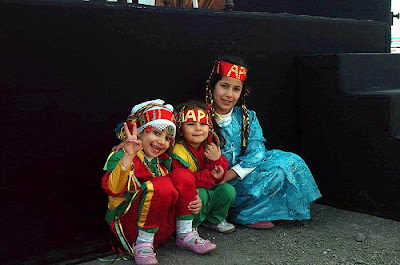Photos from Radikal
Aside from the photos, what I found most interesting about this article was the debate in the comments by the site's users.
user "rightous" says:
user "rightous" says:
Bravo to the bright women of the CHP...contemporary women...modern women...women after Ataturk...what can I say to you...I see you and I'm with you...if you weren't here, we'd be like Iran! I'm sure if Ataturk saw this in the year 2010 he'd smile at you. Or maybe it would depress him...actually should you laugh or cry at this situation...
user cankan says:
No to the charshaf! Because the charsaf means the end of the the value of the Republic and Ataturk. The Charshaf means a dark future. Let's leave our children not to the darkness of the charshaf, but to a bright future.
But user Nihat Erkan says:
user "shakanozdemir" says:
Haylemdeman:
User mustafam1:
Is Kemalism like this? When you insensitively go and rip up a çarşaf in order to thought our thoughts and opinions in a sack in order to advance some far away quarrel, the most valued principles of society are on the individual citizen, like the sword of Damocles it swings and weakens our position. [Nihat said a bit more but I had difficulty translating the entirety of his comments]
user "shakanozdemir" says:
But going this far is shameful (ayıp). What have you ripped up? Even if you haven't liked it, one part of the whole is valuable. What you have stamped upon is not just a peice of cloth, but at the same time the potential of the CHP. Take this photograph, look at is carefully and then ask - why don't we come to our potential? You've found the answer, haven't you?
Haylemdeman:
Everything for a vote...remember that during elections every citizen is a [voting] citizen.
User mustafam1:
The charshaf isn't like the turban! Didn't CHP just last year hold a "charshaf opening" and with a ceremony make women in charshafs from the suburbs members of the party? This means it isn't the charshaf that's bothering the CHP. They came out against the turban for because it was used for a "political" reason. By this reasoning do they believe that the charshaf is also being used for a "political" reason? If tomorrow women wearing charshafs (çarşafılılar) go out onto the street as a reaction to the actions of these "progressive" women and begin to cut up skirts, women's suits and pants, what will happen? In my opinion, they didn't get caught up with turbans because they are small, but they can get caught up in the charshaf and they still haven't gotten out of it, god willing (inşallah) the people will be freed from this!
I hate to be too second wave-y, but after seeing these images I had the urge to google "bra-burning 1960s," and found this image from 1968. Do you think women of CHP took some inspiration from that strategy?











